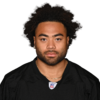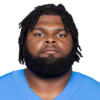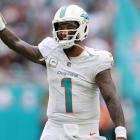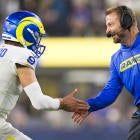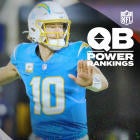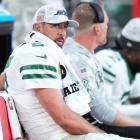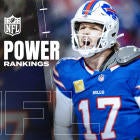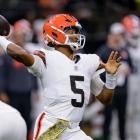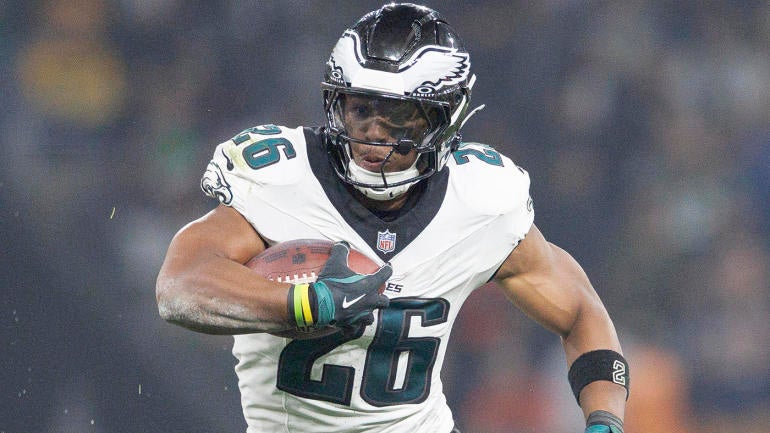
Assembling the ultimate 53-man roster is a pretty simple endeavor without any parameters. It starts getting tricky when operating under a salary cap. Roster construction becomes more complicated with other restrictions designed to prevent a squad from resembling last season's All-Pro team. The constraints bring more realism to selection process. The ground rules are as follows.
Parameters
- The salary cap for the roster is $262.7 million although the actual NFL salary cap is $255.4 million for this year. The number being used approximates the average adjusted salary cap according to NFLPA data. Each NFL team's working salary cap varies largely because unused cap room can be carried over from one year to the next. For example, the San Francisco 49ers have the NFL's highest adjusted salary cap at just under $297.36 million, largely thanks to carrying over $36.395 million of cap room, which is the most in the league. The Super Bowl LVIII champion Kansas City Chiefs have the lowest at $253.064 million, which is $2.336 million below the league-wide number. Situations like this typically occur when incentives earned during the previous season that weren't counting on the cap get accounted for without sufficient cap room carrying over from the prior year to make up the difference.
- The NFL Draft is an essential element of roster building for NFL teams. It is here also. One player from each round of the 2024 draft must be on the roster. The number requirement drops by one player for each year of the preceding three drafts (2021-2023). The limit of one player per round remains. Thus, only four 2021 draft picks are required. There's one other draft pick constraint. Only one 2020 first-round pick whose fifth-year option was exercised is allowed. This means CeeDee Lamb and Justin Jefferson can't both be selected at wide receiver. Selecting a 2020 first-round pick isn't a necessity.
- The backups at each position are limited to players who aren't established starters, were reserves in 2023 or lost a starting job this year. Young veterans cracking the lineup for the first time are eligible as reserves. Those starting last season only because of an injury are also fair game as backups. Players competing for starting jobs in the preseason or where there's a "by committee approach" at a position, usually running back, are also acceptable. A backfield containing Christian McCaffrey and Derrick Henry, 2023's leaders in rushing yards, is prohibited since both are workhorses or every-down running backs.
- Choosing a player who was given a franchise or transition designation in 2024 is optional. However, only one player receiving a 2024 designation can be selected.
Roster building philosophy
The initial version of the team was done without paying attention to cost. Over $280 million of cap space was used. Multiple roster adjustments were necessary in order to comply with the constraints.
A concerted effort was also made to keep cap numbers under $15 million. There are only three players with cap figures of more than $15 million. There were plenty of players I would have liked to include but were luxuries that couldn't be afforded because of cost. For example, quarterback Patrick Mahomes (Chiefs), wide receiver Tyreek Hill (Miami Dolphins), edge rusher Maxx Crosby (Las Vegas Raiders), edge rusher T.J. Watt (Pittsburgh Steelers) and tight end Travis Kelce (Chiefs) weren't options because of $37,133,825, $31,919,926, $30,483,250, $30,420,899 and $19,551,944 cap numbers.
Selecting a high-level quarterback was the top priority since the NFL is a passer-driven league. A cap-friendly potential franchise quarterback is the most valuable commodity in the NFL. This is because of the roster flexibility provided by the low cap number. Choosing one was a necessity.
The old football adage of "it starts in the trenches" was the overriding principle in assembling the roster. An emphasis was also placed on the offensive and defensive lines. There are three starting cornerbacks instead of a traditional base defense (either 3-4 or 4-3) since five or more defensive backs are now used over 60% of the time in the NFL.
Long-range planning wasn't taken into account so worrying about future salary cap obligations, the amount of cap room that could be carried over, expiring contracts and drafting players who might develop into starters down the road wasn't necessary. Different choices would have been made if these aspects had been considerations.
Here's the team I assembled with some of my thoughts behind the selections. The 2024 cap number for each player is in parentheses.
Offensive starters
QB: Brock Purdy, San Francisco 49ers ($1,013,073) -- 2022 seventh round
Purdy is the best value in the NFL since he is in the third year of his rookie contract as "Mr. Irrelevant," the last player selected in the 2022 NFL Draft. It would have been foolish to pass up the roster flexibility Purdy's cap number provides.
Purdy completed 69.4% of his passes for a 49ers franchise-record 4,280 yards with 31 touchdowns and 11 interceptions to post an NFL-leading 113.0 passer rating in 2023. He was an NFL MVP finalist last season.
RB: Saquon Barkley, Philadelphia Eagles ($3.8 million)
Being cost effective and having dual-threat capabilities are a requirement for the primary running back. Barkley fits that bill. His 98.8 scrimmage yards per game (combined rushing and receiving yards) ranks fifth since he entered the NFL in 2018.
WR: A.J. Brown, Philadelphia Eagles ($11,836,879)
Since being acquired from the Tennessee Titans during the 2023 NFL Draft, Brown has become the only player in Eagles franchise history to have multiple seasons with at least 1,400 receiving yards. He set an NFL record in 2023 with six straight games with 125 or more receiving yards.
WR: Justin Jefferson, Minnesota Vikings ($8.612 million) -- 2020 first round
Nobody has ever had a more productive start to an NFL career at wide receiver than Jefferson. The 2020 22nd overall pick has 392 receptions for 5,899 yards and 30 touchdowns during his first four seasons. Jefferson was the NFL's Offensive Player of the Year in 2022, which was his last healthy season. He missed seven games in 2023 with a right hamstring injury.
WR: Amon-Ra St. Brown, Detroit Lions ($4,868,930) -- 2021 fourth round
St. Brown had a career year in 2023 with 119 catches, 1,515 receiving yards and 10 touchdown receptions. He was tied for second in the NFL in catches, third in receiving yards and tied for fourth in touchdown receptions. St. Brown will spend considerable time operating out of the slot. According to Pro Football Focus, 55.1% of St. Brown's passing snaps were in the slot last season.
TE: Sam LaPorta, Detroit Lions ($2,161,128) -- 2023 second round
LaPorta set a single-season rookie record for a tight end with 86 receptions in 2023. His 889 receiving yards were the fifth most for a tight end. LaPorta led tight ends with 10 receiving touchdowns. Serious consideration was given to George Kittle. Ultimately, devoting $12,204,575 of cap resources to a tight end was too cost prohibitive.
LT: Trent Williams, San Francisco 49ers ($21,835,542)
Williams is the NFL's best left tackle. He isn't showing any signs of slowing down despite being 36 years old. His selection was made possible by his 2024 cap number being lowered from $31,568,542 when the 49ers agreed to renegotiate his contract last week to end his holdout. Otherwise, Jordan Mailata (Eagles) would have been the choice with his $11.616 million cap figure.
LG: Joel Bitonio, Cleveland Browns ($12,140,985)
Bitonio provides one of the NFL's best combinations of run and pass blocking for an offensive guard. He's adept at both. The left guard decision was made easier by Joe Thuney (Kansas City Chiefs) having a $26,971,713 cap hit.
C: Creed Humphrey, Kansas City Chiefs ($5,161,936) -- 2021 second round
The league's best center conversation focuses on Humphrey and Frank Ragnow (Lions) with Jason Kelce's retirement. Humphrey led centers with 98.8% pass-block win rate last season, according to ESPN. His modest cap number, especially compared to Ragnow's $12.8 million, made him a necessity.
RG: Chris Lindstrom, Atlanta Falcons ($9,009,765)
Lindstrom can make a case for being the NFL's top offensive guard. He earned All-Pro honors for the second straight time in 2023.
RT: Lane Johnson, Philadelphia Eagles ($15,867,250)
Johnson continues to be a standard at right tackle. He was the only right tackle to place in the top 10 in ESPN's pass-block win-rate metric (ninth) and run-block win rate (first) for offensive tackles in 2023. If Jefferson hadn't been the 2020 first-round pick who had a fifth-year option exercised, it would have been Tristan Wirfs with his $6,612,567 cap number. Wirfs would have shifted back to right tackle, his original position, before the Tampa Bay Buccaneers moved him to left tackle last season.
Defensive starters
Edge: Myles Garrett, Cleveland Browns ($20,168,895)
Garrett is the NFL's reigning NFL Defensive Player of the Year. He led the NFL in pass-rush win rate at 28.1% last season, according to PFF. Garrett's 46 sacks over the last three seasons are the second most in the NFL during this span.
DT: Chris Jones, Kansas City Chiefs ($7,350,315)
Jones assumed the title of the NFL's best interior defensive lineman with Aaron Donald retiring. He earned first-team All-Pro honors for a second straight year in 2023 with 10.5 sacks, which was the NFL's second most for an interior defensive lineman. According to PFF, Jones had 75 quarterback pressures (combined sacks, quarterback hurries and quarterback hits), which were also second among NFL interior defensive linemen.
DT: Dexter Lawrence, New York Giants ($14,575,776)
Lawrence is a force against the run and pass. His 65 quarterback pressures last season were a career high and tied for the fourth most among interior defensive linemen, according to PFF.
Edge: Nick Bosa, San Francisco 49ers ($14,673,520)
Bosa got off to a slow start in 2023, thanks to a holdout that ended a few days before the start of the regular season when he became the league's highest-paid non-quarterback (until Jefferson surpassed him in June) at $34 million per with his five-year, $170 million contract extension. Nonetheless, Bosa's 95 quarterback pressures were the third most in the NFL last season. He was 2022's NFL Defensive Player of Year with a league-leading 18.5 sacks.
LB: Micah Parsons, Dallas Cowboys ($5,434,479)-- 2021 first round
Nobody else was seriously considered as the 2021 first-round pick for the team, including Lions right tackle Penei Sewell. Although the 2021 NFL Defensive Rookie of the Year was primarily an edge rusher last year, new Cowboys defensive coordinator Mike Zimmer plans on moving Parsons around this season. Parsons, who had a career-high 14 sacks in 2023, is lining up at linebacker where he started his professional career. He will get plenty of opportunity to rush the passer from inside and out in addition to playing linebacker.
LB: Roquan Smith, Baltimore Ravens ($9,851,940)
Smith has taken his game to another level after being traded from the Chicago Bears to the Ravens during the middle of the 2022 season. He has earned first team All-Pro honors ever since joining the Ravens. A contract restructure a little over a week ago creating $3,656,250 of 2024 cap space tipped the scales in favor of Smith over 49ers linebacker Fred Warner ($13.549 million cap number).
CB: Jaylon Johnson, Chicago Bears ($13,001,260) -- Franchise player
Johnson put himself in the shutdown cornerback conversation last season. Opposing quarterbacks completed 50% of passes (25 of 50 attempts) for a 33.0 passer rating when targeting Johnson, according to PFF. He also had a career-high four interceptions.
CB: Jalen Ramsey, Miami Dolphins ($7,962,560)
Ramsey has been considered as one of the NFL's best cornerbacks ever since he entered the league in 2016. He garnered a Pro Bowl berth last season despite missing the first seven games because of a training camp meniscus tear in his left knee that required surgery. Ramsey just became the NFL's highest-paid cornerback with a three-year extension averaging $24.1 million per year.
CB: Devon Witherspoon, Seattle Seahawks ($7,254,306) --2023 first round
Witherspoon earned Pro Bowl honors last season as a rookie. His 16 passes defensed were tied for the fifth most in 2023.
FS: Jessie Bates III, Atlanta Falcons ($10,008,505)
Bates may have been the best defensive free agent signing last year. He received a four-year, $64.02 million contract from the Falcons, which made him the NFL's fourth-highest paid safety at $16.005 million per year. Bates' six interceptions were third in the NFL. He also forced three fumbles. Johnson being the franchise player eliminated Antoine Winfield Jr. (Buccaneers) from consideration.
SS: Kyle Hamilton, Baltimore Ravens ($4,438,876) -- 2022 first round
It could have gone either way between Hamilton and New York Jets cornerback Sauce Gardner for the 2022 first-round pick. It was easier to find another high-level cornerback with a manageable cap number than a comparable strong safety. Hamilton provides tremendous versatility because he can play in the box and the slot. He had four interceptions and three sacks in 2023. Hamilton's 13 passes defensed were the NFL's most for a safety.
Specialists
- K: Brandon Aubrey, Dallas Cowboys ($923,829)
- P: A.J. Cole, Las Vegas Raiders ($3,525,505)
- LS: Ross Matiscik, Jacksonville Jaguars ($1,249,450)
- KR: Derius Davis, Los Angeles Chargers ($1,103,062) -- 2023 fourth round
- PR: Davis
Aubrey connected on 94.7% of his field-goal attempts (36 of 38) in 2023. As a rookie, he hit his first 35 field goals until missing in the regular-season finale. Aubrey was perfect on his league-leading 10 conversions of 50 yards or more. Cole had an NFL-best 45.1 yard net punting average. Davis handles return duties. He led the NFL with 16 yards per punt return. He also averaged 22 yards per kickoff return. Matiscik is considered the game's best long snapper in 2023 after earning All-Pro honors. He had eight tackles, one forced fumble and one fumble recovery on special teams last season.
Reserves
Quarterback
Jake Browning, Cincinnati Bengals ($923,505)
The Bengals stayed in the playoff hunt after Joe Burrow was sidelined with a wrist injury 10 games into the season. Four of the seven games Browning started were wins. Browning threw enough passes in 2023 to qualify for league rankings. He led the NFL with a 70.4% completion percentage.
Running Backs
De'von Achane, Miami Dolphins ($1,243,344) -- 2023 third round
Jaylen Warren, Pittsburgh Steelers ($999,080)
Jordan Mason, San Francisco 49ers ($997,154)
Hunter Luepke, Dallas Cowboys ($930,486)
Achane averaged 7.8 yards per carry to pick up 800 yards on the ground last year in an injury plagued rookie season. Warren has dual-threat capabilities. The 2022 undrafted free agent rushed for 784 yards while averaging 5.3 yards per carry and caught 61 passes in 2023. Mason has demonstrated he can fill in capably for McCaffrey. Luepke is the lone fullback. Since Luepke is primarily going to play special teams, there isn't a need to tie up resources in the position with a higher cap number.
Wide Receivers
Xavier Worthy, Kansas City Chiefs ($2,509,897) -- 2024 first round
Noah Brown, Washington Commanders ($1.21 million)
Derius Davis, Los Angeles Chargers ($814,649) -- 2023 fourth round
Worthy's rare speed adds a different dimension to the team. The Texans surprisingly released Brown in the roster cutdown. He stepped up with consecutive monster games last November when the Texans receiving corps had injuries. Brown had six catches for 153 yards and a touchdown against the Buccaneers. He followed that up with seven receptions and 172 yards versus the Bengals. Davis' primary contribution is returning kicks.
Tight Ends
Isaiah Likely, Baltimore Ravens ($1,120,849) -- 2022 fourth round
Will Dissly, Los Angeles Chargers ($2,634,450)
Likely gained the Ravens' confidence by filling a void last season when Mark Andrews was sidelined for several games with an ankle injury. Dissly is primarily the blocking tight end.
Offensive line
Cornelius Lucas, Washington Commanders ($2.8 million)
Brady Christensen, Carolina Panthers ($3,014,543) -- 2021 third round
Jamaree Salyer, Los Angeles Chargers ($1,039,063) -- 2022 sixth round
Jarrett Patterson, Houston Texans ($966,314) -- 2023 sixth round
The offensive line depth is a mix of experience and youth with versatility. Lucas is the swing tackle. Christensen can play both tackle and guard spots. The Panthers heavily investing in offensive guards during free agency by signing Robert Hunt and Damien Lewis has put Christensen on Carolina's bench. He was the starting left guard before suffering a torn right biceps in the 2023 season opener. Salyer lost his starting right guard job when the new Chargers regime drafted right tackle Joe Alt with 2024's fifth overall pick. Trey Pipkins has moved inside from right tackle to take Salyer's place. Salyer can also play left tackle. He did for most of the 2022 season because of Rashawn Slater's torn left biceps. Patterson started the first seven games at center for the Texans in 2023 before fracturing the fibula in his right leg. Juice Scruggs, a 2023 second round pick, beat him out for Houston's center job.
Edge
Nik Bonitto, Denver Broncos ($1,592,098) -- 2022 second round
Austin Booker, Chicago Bears ($922,375) -- 2024 fifth round
Bonitto had eight sacks in 2023 primarily as a situational pass rusher. Booker displayed some pass rush ability during the preseason. He had 2.5 sacks.
Defensive tackles
Quinton Jefferson, Cleveland Browns ($1.98 million)
Roy Lopez, Arizona Cardinals ($1,065,080) -- 2021 sixth round
Jefferson was brought to Cleveland to provide interior defensive line depth. He had a career-high six sacks with the Jets last season. Stuffing the run will be Lopez's primary function.
Linebackers
K.J. Britt, Tampa Bay Buccaneers ($1,131,024) -- 2021 fifth round
Payton Wilson, Pittsburgh Steelers ($1,022,341) -- 2024 third round
Henry To'oTo'o, Houston Texans ($985,065) -- 2023 fifth round
Darius Muasau, New York Giants ($850,219) -- 2024 seventh round
Britt, Muasau, To'oTo'o and Wilson's main contributions will be on special teams. Britt takes over for Devin White, who signed with the Eagles in free agency. The transition started taking place in Tampa Bay's playoff games last season as Britt was on the field more than White. To'oTo'o is the primary beneficiary of Blake Cashman going to the Vikings in free agency. Steelers inside linebacker coach Aaron Curry, who was a defensive assistant with the Seahawks, surprisingly compared Wilson to future Hall of Famer Bobby Wagner because of his athleticism during the offseason. Mitch McFadden's hip injury in the preseason has opened to door for Muasau to get extensive early season playing time.
Cornerbacks
Kamari Lassiter, Houston Texans ($1,643,113) -- 2024 second round
Marcus Jones, New England Patriots ($1,419,141) -- 2022 third round
Jaylon Jones, Indianapolis Colts ($952,190) -- 2023 seventh round
Lassiter beat out Jeff Okudah for a starting job in Houston. An early season shoulder injury derailed Jones' sophomore campaign. Jones returned one of his two interceptions as a rookie in 2022 for a touchdown. He is also a candidate to be a kick returner. Jones got a baptism by fire as a rookie with the Colts last season because of cornerback injuries.
Safeties
Rodney McLeod, Cleveland Browns ($1,153,445)
Jaden Hicks, Kansas City Chiefs ($930,558) -- 2024 fourth round
Sanoussi Kane, Baltimore Ravens ($820,724) -- 2024 seventh round
McLeod, a 13-year veteran, can play either safety position. He started five of 10 games he played in 2023 because of injuries to Cleveland's secondary. ESPN analyst Louis Riddick called Hicks a star in the making during the preseason. Kane fills the 2024 seventh-round pick requirement.
Final thoughts/tale of the tape
- Total salary cap room used (53 players): $254,694,267
- Remaining salary cap room: $8,005,733
- Offense (25 players): $117,799,235
- Defense (25 players): $131,151,257
- Specialists (3 players): $5,743,775
Positional salary breakdown
(Salary cap percentage in parentheses)
- QB: $1,936,578 (0.74%)
- RB: $7,970,064 (3.03%)
- WR: $30,140,768 (11.47%)
- TE: $5,916,427 (2.28%)
- OL: $71,835,398 (27.35%)
- DE: $37,320,340 (14.21%)
- DT: $24,971,171 (9.51%)
- LB: $19,275,068 (7.34%)
- CB: $32,232,570 (12.7%)
- S: $17,352,108 (2.19%)
All of the cap room isn't being used. A cushion has been left for a full practice squad of 16 players (approximately $4.5 million) and to sign players when the inevitable injuries happen during the season. There's about $3.5 million to spare after accounting for the practice squad.
There is a bigger allocation of cap resources to defense, which is expected given the minimal cap expenses at quarterback. An amount of 44.84% of the cap went to the offense while 49.92% is devoted to defense. Offensive line accounts for 27.35% of the available cap space. It's 60.98% of the $117,799,235 in offense cap expenditures. The entire receiving corps is about $1.775 million less than Tyreek Hill's 2024 cap number.
The two Super Bowl LVIII participants, the Chiefs and 49ers, as well as the Browns lead the way with four players. Six teams (Buffalo Bills, Green Bay Packers, Los Angeles Rams, New Orleans Saints, New York Jets and Tennessee Titans) don't have a player selected. The Bills, Packers and Rams were playoff teams last season.
Rams wide receiver Puka Nacua going on injured reserve caused a late revision to the roster. St. Brown took Nacua's place at wide receiver. To'oTo'o became the 2023 fifth-round pick and knocked Jack Sanborn (Bears) off the team.







































